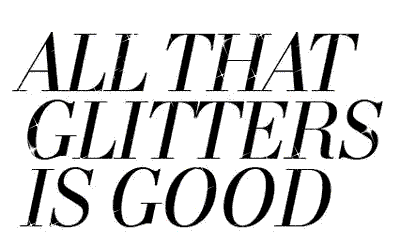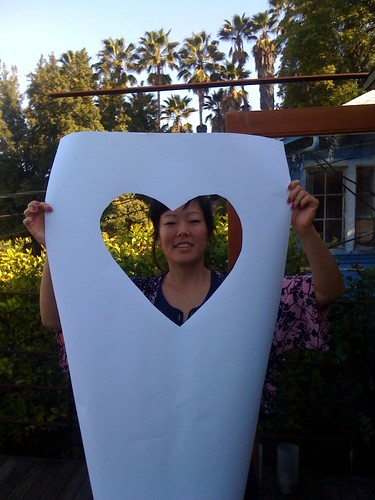Always love to see who wins the Young Architects Program competition to design the front yard of P.S. 1. Pole Dance by SO-IL doesn't look as salacious as it sounds. 
d, you're coming back to NYC for the opening, right?
2.25.2010
P.S. 1 Young Architect's Program 2010
Posted by Shin-pei at 5:39 PM 0 comments
All that glitters is good

Go for it!
Update: not public space related, nor really planning related, I realized belatedly. Did I really fall for the sparkling logo? Maybe.
UPDATE: Winners announced!
Posted by Shin-pei at 5:36 PM 0 comments
Is there such a thing has a good mall?

This made me take LEED off my business card.
Posted by Shin-pei at 7:42 AM 0 comments
2.23.2010
Neighborhood month
From GOOD
the OBJECTIVE
Make an infographic about neighborhoods and/or your neighborhood.
the Assignment
Posted by Shin-pei at 7:08 PM 0 comments
2.22.2010
Art atop billboards

Missed the MAK Center's how many billboards in LA.
Update: Was wondering how I missed the billboards when I crossed paths with the art so many times...in the car that is. I'm rarely in a car in general. Guess I never looked up in LA. I'm fascinated by driving behavior in general. Everyone trying to talk to each other while muted; imagine trying to tell someone where you are going while covering your mouth. Little signals mean a lot. I also obsess over pedestrian behavior: are they walking for fitness, fun or work, with friends, where are they walking to/from, do they cross with the light? Enthralled by the few mixed-use retail areas. It seemed like LA lacks bus shelters though there are many bus riders. Finally, I literally count cyclists, check out their bike and see if they obey traffic laws. Total urban planning-transpo-geek.
Posted by Shin-pei at 9:07 PM 0 comments
Pothole gardens


Real guerrilla gardening from the artist Pete Dungey.
Posted by Shin-pei at 4:46 PM 0 comments
2.15.2010
Fine-grain, useful mapping

Joseph O. Holmes, 20x200
[super wonky post follows]
There were many good sessions at the Active Living Research (ALR) conference, but my favorite one was the session on micro-scale GIS, based on work out of the Urban Form Lab at the University of Washington in Seattle, run by Anne Vernez Moudon (who also moderated the panel I was on) and Chanam Lee. That intersection of anthropology (specifically, collecting observations on human behavior) plus the mapping of data in local-space always gets me.
The methodology she showed us was of particular interest because it employs sophisticated tools for data that some of us working at the local level collect all the time - desire lines, most popular access points, local walking routes, local destinations, local transit use, micro-land use, etc. We do this by hand; lacking the GIS tool, we have literally hand-drawn layers of collected input on top of each other. Very time-consuming and static. Still, it's done because it's really useful for understanding neighborhood-wide transit use and the use of amenities to encourage walkability, for example.
Scale is all so important when it comes to understanding how to make tweaks to systems. An appropriately small scale at 20/50/100 feet reveals useful marks that can be easily lost when you go up to 500 feet. An example she showed us was on local transit use for Seattle. At a transit system level, the neighborhood was well-served by transit stops - an even distribution of bus stops, it appears. When individual self-identified use was mapped at a smaller scale, it became clear that one bus stop was preferred against all others. This stop is essentially the transit heart of the neighborhood. Should more resources go to reinforce this stop? What made the other stops less desirable? This mapping exercise allowed the transit agency to see more about use on the transit line than would be readily available with conventional data sets, though I'm no expert.
Perhaps the concept is well understood in the theory of urban planning, but this micro-level of spatial analysis is rarely applied to real projects going on now. It would be fun to see Open Street Map do a Micro-Street Map version allowing for local built environment condition mapping, maybe as a companion to Open Route Service. Professor Moudon, maybe you should donate your data?
(I tried to find the presentation online but it's not up yet; I'll update this post when it is).
It's not just the mapping that makes this work. The lab makes some good-looking maps too, adding to the overall persuasiveness of the work.
Posted by Shin-pei at 5:24 PM 0 comments
Woody Project

A collection of Woody Guthrie's America sung by people from many different places. Hosted by Akron Family. Send in your own version.
Posted by Shin-pei at 12:44 PM 0 comments
L.A. Mini-story




Oh L.A....groovin to a DJ at my type of club where all tables have two types of mustard // thrifting in Costa Mesa // new sharrows on 2nd St in Belmont Shore // not getting into LA Street Food Fest // Chinatown // Happy New Year! // overwhelmed by coffee indulgence of LA Mill // late night conversations around a fire pit and listening to Raymond Pettibon do spoken word backed by guitar, snare and cosmic video at a warehouse-studio-loft party - no idea where // intelligentsia // home snowy home.
Posted by Shin-pei at 10:29 AM 0 comments
2.12.2010
Research to policy change: ALR wrap-up

Nothing compares to the enthusiasm, sincerity and energy of Dr. James Sallis for Active Living Research. I first heard him speak at a NYC Fit-City conference and have been a fan ever since. He and his team have really built this small-ish area of research into a body of work on which policymakers have come to rely.
It's always good to be immersed in a context in which you're unfamiliar. The conference was fairly multi-disciplinary, as professional conferences go, with researchers, advocacy, urban planners, and designers, but it was focused on the needs of researchers. Safe Routes for Seniors and Harlem River Park ped improvement projects went over surprising well given our lack of co-efficients and model names (e.g., Likert scale a very popular one, even T.A. was in on it without knowing it).
I don't think I've seen more shorthand for concepts since...maybe college calculus. In the world of shorthand, transportation is filled with an alphabet soup of acronyms that only insiders intuitively understand (at least you can always try to figure out the words to the letters). Public health studies are full of proper nouns that researchers recognize as the author who did the past study that came up with the concept. (Hence JD got the question for the poster, "You didn't put an author for this study?" since it only had our logo on it.)
I only bring this up because I think it incredibly important that we (all of us, advocates and researchers and policymakers) make research accessible to people from all backgrounds. What is the point of research if it can't be communicated? There are so many fabulous studies that are going to come out later this year (looking forward especially to one on Bixi from the University of Montreal that might have the right data to draw some conclusions about mode shift; walkability and depression from Andrew Rundle and the Built Environment and Health group at Columbia University; and the health impact assessment of congestion pricing from the San Francisco Department of Health). Let's make it open and accessible!
Maybe next year's conference should have a working session on how to communicate the results of your study. So many smart and fabulous researchers had to talk through their posters - which presumably are a digestible version of their very long and important study - for anyone to understand what they did and found. What if the posters did the work and the people could do the discussing? I went to a lot of sessions excited by the topics listed and sometimes left wondering what the study found although I agreed with the policy recommendations in the conclusion (almost all studies had policy recommendations.)
To get us to that policy change, make it accessible. I remain excited by the potential of ALR and I'm looking forward to learning more (and getting a handle on public health proper nouns).
Posted by Shin-pei at 11:22 AM 0 comments
2.06.2010
2.01.2010
Make Bike Buddy a reality
Vote for this project - $250,000 at stake! We all know that when there's more cyclists on the road, there is greater visibility, fewer crashes and ultimately higher prioritization of bike-friendly city policy on all sides - infrastructure, enforcement, etc.
Yes, I know at least a little bit about all the big picture stuff on why biking is good - climate change, global warming, urban transportation systems ... but starting to ride in a dense urban environment can be really intimidating, especially in the beginning.
Just orienting yourself to the street - which side is best to ride on? What about an avenue? Skirting buses? Handling left turns? How do you let drivers know your movements? What's actually safe?
Then all the prepping to get on the bike: what to wear - for work, for evening parties, for long rides, to City meetings. How to stay warm or cool, what's helpful vs. extraneously cool (or dorky) gear. What should I use to carry my stuff, where do I go to buy those things? When my bike breaks down, what's something I can fix on my own and something I should take into the shop?
I was incredibly lucky to be surrounded by a large group of seasoned bike commuters when I started riding in NYC nearly two years ago. I literally had a "buddy" who was willing to work out the small details with me, like best footwear while riding, to big decisions, like which routes are the safest. People met me in the morning and rode home with me at the end of the day and at night, never resenting the fact that I doubled their trip time since I rode so slowly. They patiently showed me how to change the tube in my tire endless times and would give me a tune-up while they were at it. And after a few months (and only a few mishaps, like when I nervously stopped at a stop sign, got rattled at the too-close shy distance with a fellow biker and literally fell over slowly and sideways on top of him in front of 10 aforementioned cyclists), I started to get the hang of it.
I couldn't imagine living in the city without biking now. Riding has become one of the best ways for me to get around, live, work, and play in New York. I would love for every new bike commuter to have the same experience of getting up to speed. Go Bike Buddy!
p.s. An individual email can vote for the same idea 1 time every day during the entire voting cycle from February 1 - 28. Please vote!
Posted by Shin-pei at 11:29 AM 1 comments
